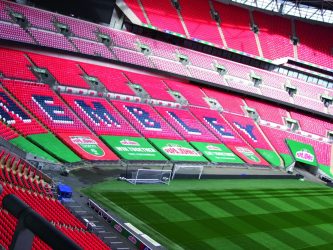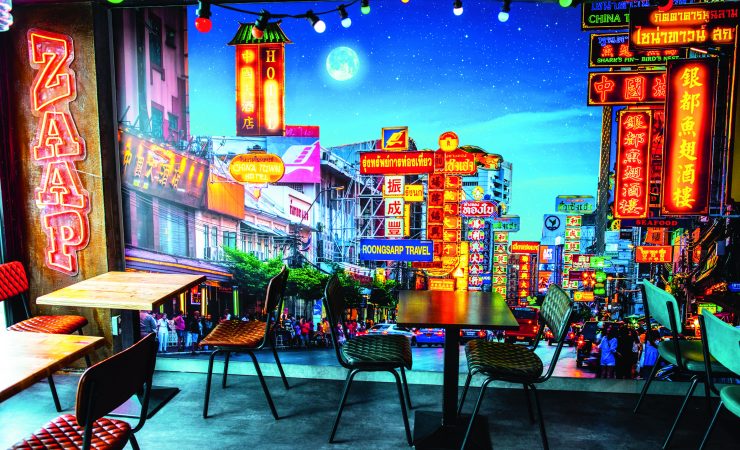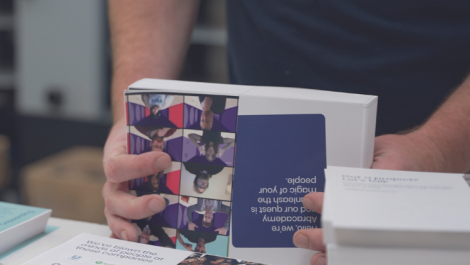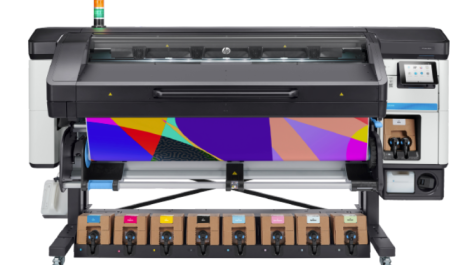It’s been a challenging 18 months for signage printers, who were left in limbo after the Coronavirus decimated events, exhibitions and the high street. But with vaccines proving effective and lockdown largely lifted, is it time to start smiling again? Charlie Kortens found out
‘How has the pandemic affected your company?’ It’s the predictable but unavoidable question and hopefully one that printers won’t have to answer for much longer, but for the moment it’s still necessary to set the scene.
Michael Green, managing director of MacroArt, says the virus had ‘an almost unimaginable impact. In March 2020, our turnover fell by 90% virtually overnight and, while there are clearly green shoots of revival within the events and exhibition industry, turnover in this sector is still weaker than pre-Covid, currently sitting at 60% of 2019 numbers.’
Unsurprisingly his counterpart at Imageco, Nathan Swinson-Bullough, largely agrees. ‘All our event work went,’ the MD told Digital Printer, ‘followed by retail and the rest. We got creative and designed products to aid the pandemic but also spent a lot of time helping the NHS with PPE. We picked up a lot of social distancing work from the outset and after a couple of months we started to get work from our customers on external rebrands. Fortunately, builders merchants remained open, so this was a godsend. Furlough was also important, we used it up until April 2021.’
Given the way key markets disappeared, it’s no surprise that both companies were forced to think outside the box. ‘With our historical dependence on event/exhibition work, it became instantly clear that business from new markets would be both vital to our immediate survival and to our future development,’ Mr Green says. ‘As a result, our sales and production teams worked tirelessly to access several new sectors. Since the first lockdown we have been active across sport, construction, retail and heritage markets, generating in excess of £1 million. These new areas have all helped get us through the downturn. In addition, as events return, they will remain a key focus in our drive to diversify.’

Earlier this year MacroArt rebranded entire sections of the national stadium overnight
Record year
‘Signage and interior work has done really well for us,’ Mr Swinson-Bullough adds. ‘I created the Green Spaces concept and we invested in a new HP Latex 800W. Our signage manager Richard has had four record consecutive quarters and we have done some large construction projects and have been rebranding some great sites around the UK for a new leisure facility. One area that did come alive was short-run packaging and bespoke seeding boxes; these were sent to influencers for retail brands and were a result of Zoom calls.’
Of course all of this doesn’t mean that the pair aren’t eagerly anticipating the return of events and exhibitions. As Mr Green says, ‘We can’t wait! Despite the search for new commercial sectors, we remain committed to maintaining our strong representation in the event and exhibition market and are optimistic that the vast majority of our historic clients will return. This, in conjunction with our newfound additional business areas, should ensure a strong and rapid ‘bounce- back’ to growth.’
Mr Swinson-Bullough is more circumspect, adding, ‘We have lost a large chunk of work from this area, thankfully we are diverse in our offerings so we have managed to cope. It’s been extremely sad, though, as we have clients and friends who solely work on events and exhibitions and we have witnessed first-hand what it has done to their businesses. We just hope that they return to full swing soon; we are now getting enquiries for later in the year, which is a good sign.’
Trends to watch
None of us can predict the future but that doesn’t mean there aren’t trends to keep an eye on. ‘The world of signage and graphics is in the very early stages of developing a ‘new normal’, and it is perhaps too early to be able to identify any new trends,’ Mr Green says. ‘However, we are confident that sustainability will remain as urgent an imperative as ever, with new initiatives and commitments coming under increasing scrutiny.
‘We also feel that a second trend will be user-friendly automation, especially in the arena of workflow and efficiency monitoring. Additionally, this automation will increasingly focus on client accessibility, providing elements like web-based libraries of existing or ongoing work, online real-time proofing and instant updating of progress reports.’
Mr Swinson-Bullough adds that, ‘There are interesting things happening with 3D print and thermoforming. Personalisation, fabrics and décor are really exciting. I do think that all printing technology providers will have sustainability at the forefront of their minds.’
Sustainability is clearly a priority for Imageco, which earlier this year gave its headquarters an environmental makeover, reducing its carbon output by more than 30,000 tonnes per year. ‘This is something I have been looking at for several years, it’s a complex topic and an area that needs to change rapidly,’ the managing director says. ‘Yes, there are products out there which are better in terms of what they are made of but many still can’t be recycled. Add adhesive, ink, laminates into the mix then you have a complex product that more often than not can’t be recycled. I think this area will develop further over the coming years.
‘I’m having discussions with recycling experts and working with one of our suppliers so that adhesive substrates can be more widely recycled. Our fabrics and one-piece wall coverings are made from recycled plastic bottles now and we offset tree planting against them with the Yorkshire Dales Millennium Trust. We still need to look at more fabrics that can be recycled; ink has a massive part to play in this. Then there is the issue of recycling collection feasibility. I’m hoping that via Fespa and my position on the board I can start to make a difference and collectively our industry can evolve to have a greener future.’

Vism’s software aims to bring all the elements of the installation process together in one place
The installation sensation
In completing an effective signage project, installation is every bit as important as printing. Despite this, project management is all too often seen as print’s poor relation. Dan Tyler, board member of Fespa UK and Founder of Vism, is providing the industry with the tools to make those installations run smoothly.
‘The traditional way of running installations has involved a mix of whiteboards, paper, WhatsApp, spreadsheets, Dropbox, shared drives… it’s all over the place,’ Mr Tyler explains. ‘What the Vism software does is bring all these elements together so that whether you handle five installations a week or 500, all aspects of the process are together in one place. Essentially, we allow companies to run all their installations through a simple dashboard where they can upload visuals, chat with installers, report through an online reporting tool, collect photos back from an installer mobile app, and more.’
The inspiration behind Vism came to Mr Tyler following a visit to a client. ‘I spent six years working as a recruiter in wide-format print,’ he explains. ‘I was working closely with firms that weren’t just selling print as a commodity, they were service-led with print forming only a part of their offering.
‘Those sorts of businesses often enjoyed the best growth, but as they grew they had to handle more installation and project management work and that presented difficulties. As a recruiter, I had a lot of installer contacts, and I thought we could build a new way for printers and sign-makers to manage their installations. I approached MacroArt to see if they’d be up for being our test case, and they jumped at the chance.
Fast forward three years and what started as almost a side-project is now a full-time job for a team and a product used by hundreds of people running thousands of installations. This growth can at least in part be ascribed to printers placing more importance on the installation process. ‘Historically, it was something of an afterthought,’ Mr Tyler concedes. ‘But over the last five years more and more printers have started to recognise that it can be a profitable part of their service offering, provided its properly managed.’
Naturally the pandemic had a huge impact on Vism. ‘When lockdown shut things down our new business pipeline disappeared, which was frustrating,’ said Mr Tyler. ‘But we were fortunate, a young company with a small team, already comfortable with remote working. We treated lockdown as an opportunity to invest in ourselves whilst we had the opportunity. In October last year we rebuilt our core product based on user feedback and have scalability built in for future expansion.’
Mr Tyler understands the problems that the pandemic has caused for the wide-format sector and he predicts that the traditional headcount-to-turnover ratio is set to shift significantly. ‘Businesses that were previously unsure about what we had to offer are now realising that they simply have to become more efficient,’ he explains. ‘Coupled with the improvements we’ve made to our offering, it has become a no-brainer for many companies.’
What other trends is Mr Tyler keeping his eye on? ‘I think that allowing people to manage things remotely will be important,’ he says. ‘But sustainability is going to be paramount. Beyond this we are seeing teams wanting to become more efficient. This doesn’t always mean investing in the newest, biggest, fastest printers, companies are looking at software instead and automation is huge.
‘There is also education and training. People appreciate the problem print has with its aging workforce and the difficulties in getting young people to consider it as a career. Coming out of the pandemic, these things will need to be at the forefront of people’s minds.’
Mr Tyler is cautiously optimistic about the future, saying that, ‘We’re already seeing the beginning of a postlockdown recovery. Printers are starting to get work for events and exhibitions again and people are out shopping. There is a lot of talk about the high street having completely changed, which it has, but it isn’t going to go away entirely.
‘What printers need to do is ask themselves what the new normal will be when it comes to retail. I think we’ll be looking at showrooms and pop-ups and, yes, there will be a big demand for print. You can have as many digital screens as you like but they don’t have print’s tactile aspect and therefore don’t have the same impact. I think we’re past the point where we can really say we’re ‘in the midst of a pandemic’ – there are still challenges but it is time to start looking forward.’





